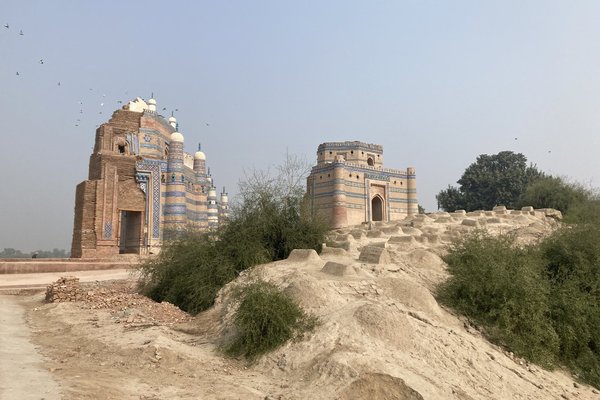Pakistan
Uch Sharif monuments
The proposal consists of five monuments, four mausoleums and a mosque, located in the historic town of Uch Sharif in Punjab province.
The shrines are dedicated to Muslim mystics (Sufis) from the 12th to 15th centuries. The monuments are domed tombs with an octagonal base and are decorated with blue and white mosaic tiles.
Site Info
Official Information
- Full Name
- Tomb of Bibi Jawindi, Baha'al-Halim and Ustead and the Tomb and Mosque of Jalaluddin Bukhari (ID: 1883)
- Country
- Pakistan
- Status
-
On tentative list 2004
Site history
History of Uch Sharif monuments
- 2004: Added to Tentative List
- Added to tentative list
- Type
- Cultural
- Criteria
Links
- UNESCO
- whc.unesco.org
All Links
UNESCO.org
- whc.unesco.org — whc.unesco.org
Community Information
- Community Category
- Religious structure: Islamic
- Secular structure: Burial
Travel Information
Recent Connections
News
No news.
Community Reviews
Show full reviews
The Monuments of Uch Sharif are on Pakistan’s Tentative List under the cumbersome name of ‘Tomb of Bibi Jawindi, Baha'al-Halim and Ustead and the Tomb and Mosque of Jalaluddin Bukhari’. They comprise a cluster of three stand-alone monumental tombs and a mosque-mausoleum in the town of Uch Sharif. They’re probably the most colourful sights you will encounter in Pakistan, and posting a photo of its iconic Bibi Jawindi tomb anywhere on social media will attract countless ‘likes’ from those who have never seen it.
Uch Sharif is considered the cradle of the ‘shrine worship culture’ that is still very present in today’s Pakistan. In the later Middle Ages, religious missionaries and scholars came from as far as Bukhara to Uch Sharif to convert local tribes to Islam. When they died, a tradition was started of veneration of their tombs and local people wanted to be buried close to them.
The four buildings of this ensemble stand together on a low hill adjacent to a river, which caused them severe flood damage in 1817. The compound has kept its original desert-like conditions and is mostly covered with small cemented graves.
The visit starts at the mosque, which already is a sight to behold. The ‘flat’ blue-tiled façade resembles those common in Uzbekistan, while the interior reminds of the Wooden Mosques of Anatolia, with painted wooden pillars ‘holding’ the roof. At the back is the entrance to the tomb of the 13th-century Sufi saint Jalaluddin Bukhari; he was …
Keep reading 0 comments
A trip to Pakistan will lead you to conclude that it is a country of Mausolea – the burial places of the leaders of various Islamic Empires and dynasties, religious leaders, “Pirs” ("saint"/"elder" or "guide") and political leaders of pre and post independence Pakistan are scattered throughout – all, to various degrees, objects of pilgrimage and veneration! Uch is a manifestation of this aspect of Pakistani Culture – and there are several more such sites on Pakistan’s T and inscribed lists! It is a small town in the Indus valley 70kms south of Bahawalpur containing around 10 tombs which constitute a major pilgrimage destination for both Sunni and Shia from Pakistan. Of these, 4 plus a mosque from the 14th and 15th centuries, are included within the T List definition for their architectural value – though there are other older ones in town.
Among the objectives for our Pakistan trip was a desire to learn more about Sufism and Qawwali music. The latter unfortunately was limited by the fact that such music is “haram” (= sinful) during the Muharram period. And, despite many long discussions with our guide, and visits to numerous Sufi shrines I must admit that a firm grasp of what Sufism is about still evades me! Uch was one of the locations where I had hoped to increase my understanding as well as tick off a T List site. But it was not to be.
Why should Pakistan be so “Mausoleum oriented”. It certainly isn’t …
Keep reading 0 comments

